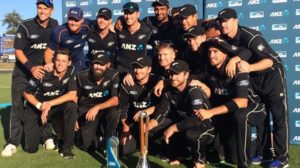
In winning the Hadlee-Chappell series 2-0, the Black Caps have defeated the Australian side twice in an ODI series in 12 months and moved to No. 3 in the official ODI rankings. This essay poses the question: can Kane Williamson’s side achieve something unprecedented in New Zealand ODI cricket history, and take the No. 1 spot?
The Black Caps have never achieved the distinction of being able to claim that they were the best ODI side in the world. At times we have come close. The current Black Caps ODI unit might have it in them to go the rest of the way.
Let’s look at the team with reference to the official ICC player rankings.
On these rankings the figure of 750 stands out as a benchmark for world-class performance. To achieve a score of 750 a player must consistently excel in comparison to their peers. It is a rare enough distinction that only six current batsmen have rating scores above 750.
Williamson had a score of 752 in January 2015, and in the two years since then has almost always stayed above that figure. If we compare his returns with that of Martin Crowe, we can see that Crowe was similar but generally below the 750 mark. Crowe, however, maintained his standard of between 700 and 750 for nine years.
In the extremely unlikely event that Williamson’s career peters out from this point, he would end up with a career ratings trajectory similar to that of Andrew Jones, who hit his peak at roughly the same time as Crowe.
Jones, who was like Williamson in that he was rock-solid at No. 3 but unlike him in that he was picked late for the Black Caps, maintained a rating above 750 for about four years.
Ross Taylor, widely regarded as the second-best bat in this current side, has maintained a Martin Crowe level of performance for the past three years, in which time he has also been between 700 and 750. He has averaged 55.89 with the bat in those last three years.
What the Black Caps of Jones and Crowe’s day didn’t have was a classy hitter at the top like Martin Guptill. Although Guptill was not world-class for the first part of his career, he got on top of his game about two years ago and since then has risen above 750. He averages over 50 in the 50 matches he has played since the start of 2015.
The Black Caps have long had a tradition of excellent ODI bowling, going all the way back to Sir Richard Hadlee, who was one of the best of all. At one point the Black Caps had the rare distinction of having three of the top five ODI bowlers, in Shane Bond, Daniel Vettori and Kyle Mills.
Vettori was the only one of those three to be truly world-class for a decent length of time – Bond suffered many problems with injury and Mills was not enough of a wicket threat to really be considered in that top bracket.
The most skilled Black Cap with the ball currently is Trent Boult, who is ranked No. 1 in ODIs. Boult is a curious case, because he hasn’t even been in the ODI side very long. He has, however, maintained a bowling rating of 750 or thereabouts for most of the past 18 months, during which time he has also struggled for fitness.
But given that he is rapidly improving and is only 27, this column contends that over the next few years, Trent Boult will establish himself as the best ODI bowler in the world. He might not have quite as many wicket deliveries as Mitchell Starc, but he is far more relentlessly accurate and incisive.
Perhaps the major weakness of today’s Black Caps side in comparison to those of past years is the absence of a world-class allrounder. When Cairns, Oram, Styris and Vettori were operating the team had both depth and flexibility.
Certainly there is potential among the current wider squad for a quality No. 6 to emerge. Corey Anderson has even more potential than Cairns, but can’t stay on the field long enough to make an impact. Jimmy Neesham appears to have the goods, but has been unable to translate it into class in ODIs. The best bet going forward might be Mitchell Santner, as the errors he makes tend to be errors of inexperience.
With four world-class players in Williamson, Taylor, Guptill and Boult, and a handful of potential ones in Matt Henry (currently ranked 7 in ODI bowling but can’t make the side), Santner, Anderson, Tom Latham, Lockie Ferguson and Adam Milne, the Black Caps side of 2017 looks to have both a stronger core and much greater depth than ever before.
All it would take would be to maintain those standards or gradually improve them over time as players naturally get more experience, and the Black Caps will surely claim the No. 1 ranking sooner or later.
This side could actually take the No. 1 ranking fairly soon if enough results went in their favour. A 3-0 win in the ODI series against South Africa later this month is far from unthinkable, considering they just beat the world champion Australians 2-0 at home.
That would leave them second, two points behind Aussie, and therefore within striking range of the previously unachievable.
